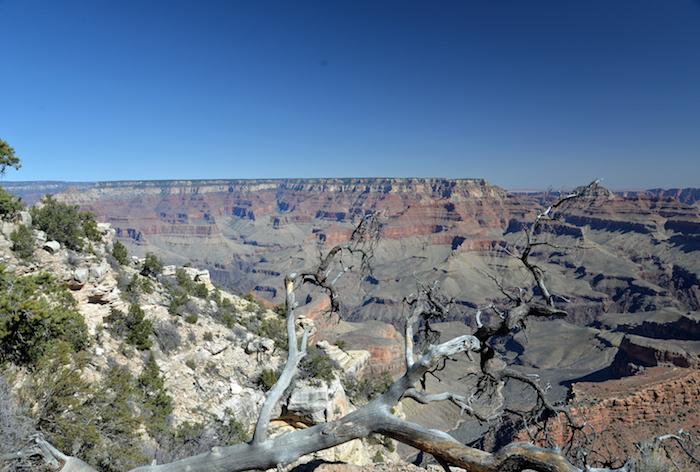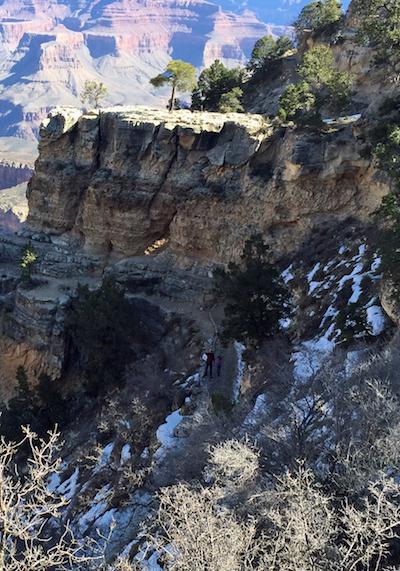
Shoshone Point, Grand Canyon National Park/EC Buck
It was some sense of anticipation that I departed Durango for my 5 1//2 hour drive to the Grand Canyon.
Some 20 years ago I had made this same journey with my wife and three young children, ages 3 to 7, as part of a two-week tour of the Southwest. While we had visited Bandelier near Santa Fe, New Mexico, Grand Canyon was our (and my) first major western national park. My memories have faded substantially of that first visit when we stayed a single night. I remember the spectacular views, as I have a sunrise picture I took framed and hanging in my office. But other than that, my recollection was that unless you were hiking into the canyon, a single day was sufficient to see the park.
Now I was wondering, would this second trip, accompanied by my wife, 6-year-old granddaughter, and 8-year-old golden retriever lead me to the same conclusion?
I also was looking forward to evaluating Grand Canyon in frame of many of the discussions that I have read and engaged in on the Traveler. Having previously visited Great Sand Dunes National Park and Mesa Verde on this trip, I was already solidifying, forming, and even changing some opinions. But Grand Canyon was certain to play a major role in my thoughts.
An hour-and-a-half outside of Durango, Colorado, is Four Corners Monument. The monument marks the point at which Colorado, Utah, Arizona, and New Mexico meet. This is not a national park. It isn’t even a national monument. In fact, it is private property located in the middle of nowhere in the Navajo Nation.
The "monument" is a metal medallion perhaps 8 feet across surrounded by concrete (wooden 20 years ago) booths with Native Indians selling authentic Indian wares, from jewelry to tomahawks and arrows. Despite the less than impress landscape and facilities, we turned in, paid our $5 per person (not per car) to take the traditional “straddling of the four corners” picture.
This was my first National Parks Traveler conversation moment. We just paid $15, the price of a week at some national parks, for a 10-minute photo opportunity. We weren’t the only ones. Despite the fact it was off season and a brisk day, there were numerous visitors, driving everything from BMW’s to 20-year-old Chevys paying up.

The Four Corners straddle/EC Buck
If people were willing to pay $5 per person for this experience, weren’t the parks worth far more? Yellowstone, or Yosemite or Grand Canyon at $25-30 a car load even for just a day, much less a week, were a bargain compared to Four Corners National Moment.
The annual and senior passes are an even bigger (too big) bargain. I paid more at Four Corners for 10 minutes than I spent on my Senior Pass that has already yielded me and my family weeks of national park pleasures. Perhaps at one point the thought process was that a low Senior Pass rate would encourage seniors to visit the parks and that seniors where more likely to spend money in park lodging and concessions. If so, that isn’t necessary now. The parks are getting full and their purpose is not to serve the concessionaires but to protect the resources and serve the public.
Our next milestone and National Parks Traveler revelation occurred at Cameron, Arizona, the eastern “gateway” to the Grand Canyon. Many articles and comments on the Traveler have suggested that the establishment of an area as a national park is an automatic economic boom to the surrounding gateway communities. Cameron has a couple of gas stations and the typical, though larger than usual, souvenir shop selling everything from tasteful to tacky.
With a population of less than 1,000, Cameron could hardly be described as a thriving metropolis, except perhaps when compared to Hooper, Colorado, the gateway to Great Sand Dunes or Mancos, Colorado, gateway to Mesa Verde, both of which we had visited earlier on this trip, or Baker, Nevada, the gateway to Great Basin where I camped two years ago.
The fact is, naming something a "national park" does not automatically create substantial economic activity in the surrounding communities. In fact, it may hurt that activity. Those parks with true unique resources, the Grand Canyon, Yosemite Valley, Zion Valley, for example, were being exploited as tourist destinations long before they became national parks. Ralph Cameron began development of the Bright Angel Trail (a toll road) in 1890, and the Santa Fe Railroad built the Hermits Rest Trail to serve a luxury campsite in 1911, eight years before the park was established. If the park had not been established, there is little doubt that such commercial development would have multiplied and led to economic activity, both within and outside the park that would have far surpassed what is generated by the park today.
Making the “economic stimulus” argument to support the parks is just wrong. It is inaccurate because it ignores the economic activity that would have occurred otherwise and it misses the point of the parks. It isn’t the purpose of the parks to generate economic activity. Their purpose is to protect the resources for the enjoyment of the people. That is a delicate balance and many people have differing balance points. Some want the parks left pristine with little human interaction; others would like to see Ferris wheels and roller coasters. I must say in my experience at Grand Canyon and other parks, I believe the National Parl Service has done a remarkable job of finding that balance. I recall my first trip to Yellowstone decades ago I was fearful it would be overly commercialized, but I was pleasantly surprised at the balance between front country amenities and backcountry opportunities.
Grand Canyon lacks Yellowstone's extensive backcountry network but still has kept a comfortable balance. Grand Canyon is also the most dog friendly national park I have yet visited. The Rim Trail, a paved path paralleling the canyon’s rim, as the name suggests, is fully accessible to dogs. This trail spans some 13 miles from Hermits Rest at the far west to Yaki Point at the east. One can get to every major viewpoint and facility with dog at their side. Grand Canyon National Park even has a less-known dirt road that affords a one-mile hike out to Shoshone Point where dogs are allowed. I highly recommend this hike to get away from the crowds and get some great views and as we did, see some wildlife.
While I never saw any dog waste, there was plenty of human litter along the Rim Trail. Grand Canyon has eliminated the sale of plastic water bottles in the park but continues to sell many other beverages in plastic. Notably, we didn’t encounter any plastic litter, though the trash cans provided evidence that plastic bottles were abundant. What we did find were many paper products, especially coffee cups and napkins/tissues, which we picked up as we walked. Will these be “eliminated” next? I still believe the plastic bottle bans are needless, ineffective and silly. But then I would say the same thing about the people that litter, and we probably won’t eliminate them.
There are many other aspects of the park I would enjoy addressing, including maintenance, the wonderful restaurant at El Tovar, the broad range of accommodations, the role of international visitors, the great rangers and much more, but I will finish up for now with some thoughts on addressing park capacity. We were in the park in what would be deemed the off season yet the weather was wonderful and all the South Rim facilities were open. The Bright Angel trail was a little treacherous as it was still covered in packed ice where it hugged the canyon wall, but the mules where making their daily trips and it was certainly passable with crampons. Lacking mule or crampons, my granddaughter and I ventured only a few hundred yards down through the first tunnel to see the petroglyphs our waiter had told us about the previous night.
The point here is that there is much to see and enjoy in the off-season. Perhaps the parks should work on developing programs that will encourage off-season visitation. This will leverage the existing infrastructure and shift some traffic away from today's usual peak periods. We have the same issue here in Colorado ski country. Every Saturday and Sunday morning, I-70 is bumper to bumper with traffic, and the same is true for a few hours in the afternoons as skiers return to Denver. The rest of the week and through the ski-off season the highway is more than adequate.

The icy Bright Angel Trail/EC Buck
For some, the answer is building more lanes or a $60 billion train that no one will ride – the equivalent of building more roads and parking in the parks. I believe instead we should develop programs to encourage people to come at the non-peak times. For the ski areas, drive up Friday morning and head home Monday morning. For the parks, visit in February, March, and April instead of June, July and August. Sure, not everyone can do that, but our increasingly flexible work schedules and advancing technology (wire the parks!) could allow that to happen for many.
One final note. Our parks are all special places, but they also are all unique. A single mission is not appropriate for all. At Mesa Verde, the primary goal should be the preservation of irreplaceable artifacts from the ancient past. The focus of Yellowstone or Great Smokey Mountains national parks should probably be more focused on recreational activities such as hiking, camping, fishing or boating.
While protection should be foremost in our park management, as users we must understand that not every park offers the same opportunities and not everyone has the same interests or opinions. To the extent possible, we should be willing to compromise and accommodate those differences. It’s not black-and-white, it is all shades of grey.
PS: Two nights in the park were better than one, even though we didn’t hike to the canyon floor.



Comments
With respect to Grand Canyon NP, if I'm reading you correctly, you've not been to the North Rim, which is a shame. This is a higher, forested area. The North Rim is not open year round. In late May 1990, my wife, I ,and another couple went to both rims. If you place your nose in the a Ponderosa Pine's bark's crack you will smell either vanilla or butterscotch. The number of people was a fraction of the number we encountered on the South Rim. I woud suggest walking along (some of) the North Rim's Widforss Trail.